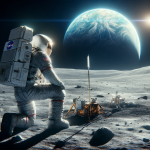Eleasa Kim, a pivotal figure at NASA, spearheads the Commercial Low Earth Orbit Development Program (CLDP) payload operations at Johnson Space Center. With 18 years of mission support experience, she has held various roles, enriching her knowledge in engineering, safety, and leadership. Currently, she ensures a seamless transition to commercial space operations, enhancing scientific research in microgravity. Kim’s commitment to safety and inclusion within NASA is evident through her leadership role in the Human Exploration and Development Office’s (HEDO) Unity Team, advocating for a progressive organizational culture.
During her tenure as an International Space Station biomedical engineer, Kim completed a parabolic flight to test crew health support hardware, cherishing the team’s camaraderie. Previous roles include payload planner, payload safety engineer for Artemis I, and operations discipline lead at Marshall. Each position provided unique challenges and learning opportunities, fostering her adaptability and curiosity. Kim’s diverse experiences underline NASA’s emphasis on continuous improvement and cultural integration, aligning with the agency’s evolving goals.
Seamless Transition to Commercial Operations
Kim evaluates commercial space station plans and prepares materials for research operations. She devises strategies to enhance partner success and sustain the low Earth orbit economy. Emphasizing trust and collaboration, she welcomes brainstorming and recommendations for transitioning space station operations to commercial platforms. Her involvement with the Unity Team at Marshall highlights her dedication to a safe and inclusive work environment, addressing complex topics to improve organizational culture.
Diverse Roles and Learning Opportunities
Kim’s various roles at NASA have enriched her understanding of mission operations, safety, and project management. She has supported real-time mission operations, pre-mission planning, and project management. Each role demanded adaptability and offered opportunities to learn and lead multiple teams. Kim emphasizes the importance of staying curious and adaptable, recognizing that each role presents unique challenges. Her commitment to continuous learning and leadership reflects NASA’s innovative and inclusive culture.
Kim’s leadership in promoting a culture of safety and inclusion is evident in her efforts to provide safe spaces for vulnerability and contribution. She believes that consistent communication from every individual is crucial in driving change. Her approach aligns with NASA’s goal of reshaping its culture from the ground up, supported by management. Kim’s dedication to people-centric leadership fosters an environment where everyone feels valued and motivated to contribute.
Key Inferences for Readers
- Effective leadership involves promoting a culture of safety and inclusivity.
- Adaptability and continuous learning are crucial in diverse roles.
- Consistent communication is key in driving organizational change.
Kim’s career at NASA showcases the importance of diverse experiences in fostering growth and innovation. Her commitment to leadership, safety, and inclusion has significantly contributed to the agency’s mission. Kim’s ability to adapt and learn in various roles highlights the value of versatility in achieving professional and organizational goals. Her passion for connecting with people and adding value reflects a profound understanding of effective leadership and collaboration.
Kim’s cultural heritage and personal life also play a significant role in her professional journey. Raised in America with Korean roots, she appreciates her cultural background and enjoys sharing traditional meals with friends and colleagues. As a mother of two, she is proud of her daughters and aims to inspire the next generation to achieve great things for humanity. Kim’s multifaceted experiences and dedication to NASA’s mission exemplify the agency’s commitment to fostering an inclusive and innovative work environment.










